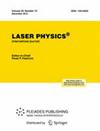Optical dipole potential energy of a two-level atom interacting with a tightly focused truncated optical Bessel beam
IF 1.1
4区 物理与天体物理
Q4 OPTICS
引用次数: 0
Abstract
Abstract Truncated optical Bessel (TOB) beams are an orthonormal set of optical vortex beams that possess orbital angular momentum (OAM). It is characterized by a significant longitudinal electric field component at the sub-wavelength scales. The photons of a circularly polarized TOB beam also carry spin angular momentum (SAM) and can interact with a two-level atom, in the far-off resonance regime, giving rise to an optical dipole potential energy that involves a spin–orbit term that stems from the inclusion of the longitudinal field component. When a two-level atom is simultaneously irradiated by two TOB beams, the optical dipole potential energy, in some special cases, is entirely dependent on the OAM–SAM coupling. We explore the cold-atom trapping options enabled by the use of TOB beams, either single ones or combinations thereof. We put emphasis on case in which the OAM–SAM coupling is the dominant contribution. The similarities and differences between the results obtained for the TOB beams and those for the Laguerre–Gaussian beams are also discussed.两能级原子与紧聚焦截断贝塞尔光束相互作用的光学偶极子势能
截尾光学贝塞尔光束是具有轨道角动量的一组正交光学涡旋光束。它的特点是在亚波长尺度上有显著的纵向电场分量。圆偏振TOB光束的光子也携带自旋角动量(SAM),并且可以在遥远的共振状态下与二能级原子相互作用,产生光学偶极子势能,该势能涉及自旋轨道项,该项源于纵向场分量的包含。当两个TOB光束同时照射一个二能级原子时,在某些特殊情况下,光学偶极子位能完全依赖于OAM-SAM耦合。我们探索了使用TOB光束,无论是单一的还是组合的冷原子捕获选项。我们把重点放在OAM-SAM耦合是主要贡献的情况下。讨论了TOB光束与拉盖尔-高斯光束结果的异同。
本文章由计算机程序翻译,如有差异,请以英文原文为准。
求助全文
约1分钟内获得全文
求助全文
来源期刊

Laser Physics
物理-光学
CiteScore
2.60
自引率
8.30%
发文量
127
审稿时长
2.2 months
期刊介绍:
Laser Physics offers a comprehensive view of theoretical and experimental laser research and applications. Articles cover every aspect of modern laser physics and quantum electronics, emphasizing physical effects in various media (solid, gaseous, liquid) leading to the generation of laser radiation; peculiarities of propagation of laser radiation; problems involving impact of laser radiation on various substances and the emerging physical effects, including coherent ones; the applied use of lasers and laser spectroscopy; the processing and storage of information; and more.
The full list of subject areas covered is as follows:
-physics of lasers-
fibre optics and fibre lasers-
quantum optics and quantum information science-
ultrafast optics and strong-field physics-
nonlinear optics-
physics of cold trapped atoms-
laser methods in chemistry, biology, medicine and ecology-
laser spectroscopy-
novel laser materials and lasers-
optics of nanomaterials-
interaction of laser radiation with matter-
laser interaction with solids-
photonics
 求助内容:
求助内容: 应助结果提醒方式:
应助结果提醒方式:


